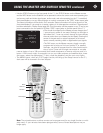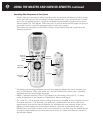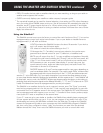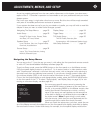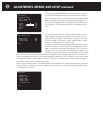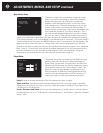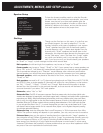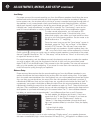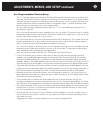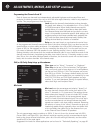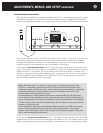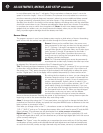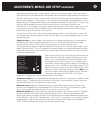
Speaker Setup
To hear the closest possible match to what the filmmak-
ers heard when they mixed their soundtracks, your home
theater must be set up so that each speaker gets the
proper signals, that no speaker is louder or softer than it
should be, relative to the others, and so that the sound
from each speaker arrives at the proper time.
Size Setup
Though not the first item on this menu, it is the first one
you should program; it’s used to adapt the C 1 to the
number, locations, and types of speakers in your system.
“Small” speakers are those with limited bass capacity;
to avoid distortion, the C 1 diverts bass signals from any
channels with “Small” speakers and sends them to the
subwoofer; this diversion takes place at the frequency set
on the “Size setup” menu. The bass from “Large” speak-
ers, which can handle it well, is not normally sent to the
sub. If you’re not sure if you should classify your speakers
as “Small” or “Large,” try both settings and see which sounds best.
Main speakers, the left and right front speakers, may be set as “Large” or “Small.”
Center speaker may be set to “Large,” “Small,” or “No.” If your system has no center speaker, set
this to “No” so the C 1 will divert any center-channel signals into your front left and right speakers.
This is sometimes referred to as a “Phantom” center because, even without an actual center-
channel speaker, you will still hear sound apparently coming from between your front speakers.
Surround speakers, which are placed at the sides of the room, may also be set to “Large,”
“Small,” or “No.”
Back speakers are used for 6.1- or 7.1-channel soundtracks such as Dolby Surround EX, THX EX,
and DTS ES. Here, a single speaker (6.1-channel) will suffice for many listeners, so the options
are “No,” “1 Small,” “1 Large,” “2 Small,” and “2 Large.” Back-channel information is always
derived from the information in the surround channels, so those sounds will be heard in the
surround channels if you select “No” back speaker.
Subwoofer, select “Yes ” or “No.”
Subwoofer filter (On-Off): A low-pass crossover filter that passes only the low bass (which sub-
woofers are designed to reproduce), and blocks upper bass, midrange, and treble (which subwoofers
reproduce very badly). Most self-powered subwoofers, and many passive subs, have such filters
built in; still, you might prefer to use this filter instead, because it works in the digital domain and
therefore filters (at 12 dB per octave) without creating phase alterations. Don’t use both the filter
in your sub and the filter in the C 1, or some frequencies you want may not be heard at all. If your
sub doesn’t have a bypass switch for its crossover filter, adjust it to its highest frequency setting
to minimize redundant filtering.
Subwoofer freq. sets the subwoofer filter’s cutoff frequency, in 10-Hz increments from 40 to
140 Hz. The optimum setting will depend on your speakers, your sub, and your room’s acoustics.
Enhanced bass gives you the option of sending bass from channels with “Large” speakers to
the subwoofer as well. (When all speakers are set to “Large,” the subwoofer normally gets only
the Low Frequency Effects, or LFE, signal.) Switching Enhanced Bass on will give you more
bass energy, but switching it off may make the sound clearer–or even louder, in some rooms
–because it eliminates the possibility of phase problems that can occur when speakers in differ-
ent parts of the room reproduce the same bass tones.
Size setup
᭤ Main speakers Small
Center speaker Small
Surround speakers Small
Back speakers No
Subwoofer Yes
Subwoofer filter On
Subwoofer freq. 100 Hz
Enhanced bass Off
Exit
Speaker setup
Level setup
Distance setup
Size setup
Aux channel setup
᭤ Level autocalibrate?
Dist. autocalibate?
Exit
ADJUSTMENTS, MENUS, AND SETUP continued
27



